

Slovenia is a wine-growing country located in the heart of the European wine belt, boasting an exceptionally diverse selection of wine varieties. It is among the countries where the largest proportion of agricultural land is dedicated to vineyards.
Slovenia has around 17,000 hectares of cultivated vineyards, with nearly 14,600 hectares registered for the purpose of marketing grapes and wine. Annually, Slovenia produces between 600,000 and 950,000 hectoliters of wine. There are over 2,500 registered wine producers who also bottle their own wine. Slovenia is characterized by a high fragmentation of vineyard owners, with 85% of them cultivating less than half a hectare of vineyards, and vineyards up to 1 hectare in size encompassing 91% of all producers
Wine is produced in three wine-growing regions – Podravje, Posavje, and Primorska – which differ mainly in terms of their location, terroir, and characteristic climate. The wine-growing regions are divided into a total of nine wine-growing districts, which further consist of wine-growing sub-districts, wine-growing narrower districts, wine-growing localities, and wine-growing sites.
The wine-growing region of Podravje comprises 5,840 hectares of cultivated vineyards and is located in the northeast of the country. It is divided into two districts: Štajerska Slovenija (5,400 ha) and Prekmurje (440 ha) and includes areas from the Hungarian border (around Lendava and Goričko), the slopes of Pohorje, Slovenske gorice, Haloze and Kozjansko (along the Croatian border).
Podravje is characterized by a distinctly hilly landscape with an average altitude of vineyards between 250 and 400 meters above sea level. Most of the soil was formed on carbonate rocks and on Pleistocene loams, which is a very favorable basis for the development of vines, which have been thriving here since ancient Roman times. The climate has continental characteristics, with an average annual rainfall of around 1000 mm and hot summers and cold winters.
The favorable composition of the soil and the climate create elegant white wines of international varieties and some indigenous ones. White grape varieties are planted on as much as 93% of the area. The most represented and well-known varieties are Welschriesling, Sipon (Furmint), Rheinriesling, Chardonnay, Sauvignon Blanc, Yellow Muscat, Traminer and Pinot Blanc. Among the red varieties, Blaufränkisch, Pinot Noir and Žametovka are especially represented.
WHITE: Welschriesling, Shipon, Rhine Riesling, Chardonnay, Sauvignon Blanc, Yellow Muscat, Traminer and Pinot Blanc.
RED: Blaufränkisch, Pinot Noir and Žametovka.
Štajerska Slovenia is the largest wine-growing district in Slovenia. It is a diverse landscape with slopes in the Haloze Hills and terraces in the Ljutomer-Ormož Hills. In the northern part, the hills merge with the Radgona-Kapela Hills, which descend towards Prekmurje and the Pannonian Plain. The region has renowned vineyard sites that are classified among the top 5 percent of the best vineyard locations in the world.
The Štajerska Slovenia wine-growing region consists of six wine-growing sub-regions: Maribor, Radgona-Kapela (Radgona-Kapela Hills), Srednje Slovenske gorice, Ljutomer-Ormož (Ljutomer-Ormož Hills), Haloze with its peripheral hills, and Šmarje-Virštanj.
Soil and Climate: The cold Pohorje Mountains in the west and the influence of the warm Pannonian Plain in the east shape a moderately cold Pannonian or sub-Pannonian climate, characterized by significant temperature differences between day and night, relatively dry summers, and proper winters. Together with sandy-clay, occasionally loamy and limestone soils, it creates excellent conditions for elegant, varietally distinctive white wines and blends.
Grape Varieties and Wines: The ratio between white and red grape varieties favors whites, as approximately 95% of vineyards are planted with white grapes. The most well-known varieties include Sauvignon Blanc, Riesling, Pinot Gris, Muscat, Gewürztraminer, and Chardonnay.
In the wine-growing region, in addition to dry and off-dry varietal wines and blends, we also produce exceptional premium semi-sweet and sweet wines of special quality, such as late harvest, selection, berry selection, ice wine, and dry berry selection.
Štajerska Slovenia is also known for its sparkling wines - "penina" - produced both by the Charmat method and the traditional bottle fermentation method.
Prekmurje, the second smallest wine-growing district in Slovenia, is located in the far northeast of the country on the left bank of the Mura River. It borders Austria, Croatia, and Hungary. In addition to plains, Prekmurje also features hilly areas such as the Lendava Hills and Goričko, where grapevines thrive.
Prekmurje is situated on the outskirts of the warm Pannonian Plain, which contributes to the production of rich and full-bodied wines in this district.
The Prekmurje wine-growing district comprises three sub-districts: Lendava, Goričko, and Strehovsko-Dobrovniško-Kobiljske gorice.
Soil and Climate: The soil in Prekmurje is mostly carbonate, with some remnants of volcanic rocks. Acidic, brown soils alternate with sandy loams, while clayey and loamy soils can be found in other areas. The sub-Pannonian climate influences the temperatures, sunlight exposure, precipitation, and windiness. Summer and autumn temperatures are generally very high, which is favorable for grapevines and grape ripening. Precipitation is relatively low.
Grape Varieties and Wines: Despite a long tradition of winemaking, Prekmurje winemakers in Slovenia have not enjoyed a high reputation, as they primarily produced simpler wines for everyday consumption. However, this is changing today, as they are increasingly producing more complex red wines alongside the predominant white varieties, including predicate wines.
Recommended grape varieties: Laški Rizling (Welschriesling), Renski Rizling (Rhine Riesling), Šipon (Furmint), Zeleni Silvanec (Green Sylvaner), Sauvignon, Sivi Pinot (Pinot Gris), Beli Pinot (Pinot Blanc), Chardonnay
Allowed grape varieties: Rizvanec, Ranina, Rumeni Muškat (Yellow Muscat), Muškat Ottonel (Muskat Ottonel), Traminec (Gewürztraminer), Bela Žlahtnina, Kerner, Modri Pinot (Pinot Noir), Modra Frankinja (Blaufränkisch), Rdeča Žlahtnina, Zweigelt
The Posavje wine-growing region is the smallest wine-growing region in terms of size, covering 2350 hectares. It is located in the southeastern part of the country and borders Croatia. It is divided into three wine-growing districts: Dolenjska (1350 ha), Bizeljsko-Sremič (700 ha), and Bela Krajina (300 ha).
It lies along the lower course of the Sava River and encompasses the area west of the Sotla River, Posavje, and the surroundings of the Krka and Kolpa Rivers.
The moderately hilly landscape is often characterized by narrow valleys and steep slopes, where even grapevines prevent soil erosion. The soil is mostly composed of marls and sandstones with limestone binding. The average annual precipitation ranges between 1,070 and 1,200 millimeters, with characteristics of a continental climate and influences from the cooler sub-Alpine climate.
In the Posavje wine-growing region, there is a larger area planted with red grape varieties than white varieties (red varieties cover 58% of the area, while white varieties cover 42%). The predominant grape varieties include Žametovka, Modra frankinja (Blaufränkisch), Laški rizling (Welschriesling), and Kraljevina. These varieties also form the basis for the wine Cviček, which, along with Tuscan Chianti, is one of the few wines in the world made from a blend of red and white grape varieties.
Žametovka, Modra frankinja (Blaufränkisch), Laški rizling (Welschriesling), Kraljevina, Cviček
The wine-growing district of Dolenjska stretches from the right bank of the Sava River (approximately from the municipality of Litija) along the banks of the Krka River to the southeastern border with Croatia. It consists of smaller hills that are separated by smaller or larger valleys. The vineyards are located on more or less steep slopes up to an altitude of 400 meters.
The wine-growing district includes four wine-growing sub-districts: Krško, Gorjanci, Novo mesto, and Trebnje-Krmelj.
Soil and Climate: The Dolenjska wine-growing district is the coldest district in Slovenia. It has a continental climate with Alpine and sub-Pannonian influences, characterized by very cold winters and warm summers. Annual precipitation mostly does not exceed 1,100 millimeters and is evenly distributed throughout the year. The geological composition of the soil in Dolenjska is highly diverse, ranging from slate, sandstone, and marl to predominant limestone and dolomite.
Grape Varieties and Wines: Dolenjska is most famous for "cviček," a light red wine with low alcohol content and a distinctive bouquet of red berries. In addition to cviček, an increasing number of winemakers are choosing to produce varietal wines, primarily from Modra frankinja (Blaufränkisch) and Sauvignon Blanc. Recently, Dolenjska has experienced a revival with rosé wines and excellent sparkling wines made using the traditional method from the indigenous Žametovka, Chardonnay, and Pinot Noir.
Recommended grape varieties: Laški rizling (Welschriesling), Beli pinot (Pinot Blanc), Sivi pinot (Pinot Gris), Chardonnay, Modra frankinja (Blaufränkisch), Žametovka (Velvet Noir)
Allowed grape varieties: Zeleni silvanec (Green Sylvaner), Renski rizling (Rhine Riesling), Sauvignon Blanc, Rumeni muškat (Yellow Muscat), Kraljevina, Ranina, Rumeni plavec, Kerner, Traminec (Traminer), Dišeči traminec (Gewürztraminer), Bela žlahtnina, Ranfol, Scheurebe, Modri pinot (Pinot Noir), Rdeča žlahtnina, Portugalka (Portuguese), Šentlovrenka, Zweigelt, Gamay
Bela Krajina is the smallest Slovenian wine-growing district. It is located in the southeastern part of Slovenia, between the Gorjanci Hills, the Kočevski Rog, and the Kolpa River, which forms the border with Croatia.
The wine-growing district comprises three sub-districts: Metlika, Črnomelj, and Semič.
Soil and Climate: It is the warmest Posavje wine-growing district with a continental, sub-Pannonian climate and Mediterranean influences. The predominant geological composition is limestone and dolomite, with the presence of red clay, marl, sandstone, and slate. The significant temperature difference between day and night allows for the production of aromatic wines that maintain their freshness.
Grape Varieties and Wines: Various styles of wine are produced in Bela Krajina. Traditionally, the most produced were light and drinkable varieties such as Belokranjec (white) and Metliška črnina (red). However, in recent times, more emphasis has been placed on varietal wines, with yellow muscat standing out among the white varieties in terms of quality. The red variety increasingly gaining importance is Blaufränkisch (modra frankinja).
A special feature of the region is the production of predicate wines, where sweet wines of exceptional quality with aging potential of several decades are made using noble rot. In 1986, the first ice wine in Slovenia was produced in Bela Krajina.
Recommended grape varieties: Welschriesling, Pinot Blanc, Sauvignon Blanc, Pinot Gris, Chardonnay, Yellow Muscat, Blaufränkisch, Žametovka.
Allowed grape varieties: Sylvaner, Riesling, Ranina, Kraljevina, Traminer, Gewürztraminer, Kerner, White noble, Pinot Noir, Gamay, Zweigelt, Portugalka, Šentlovrenka, Red noble.
The wine-growing district of Bizeljsko-Sremič encompasses an area on the left bank of the Sava River, between the town of Zidani Most and the vicinity of Dobova (in the south), and it borders Croatia along the Sotla River. To the north, it borders the wine-growing region of Podravje. The vineyards are situated at elevations between 200 and 400 meters above sea level.
The wine-growing district includes the wine sub-districts of Bizeljsko and Sremič, as well as the wine locality of Kapele.
Soil and Climate: The climate is continental with Pannonian influences. Winters are cold, summers are warm, and in recent years, they have been increasingly hot. Spring and autumn are milder and more humid. The soil is highly diverse, predominantly consisting of limestone and marl substrate with sandy soil mixed with loam.
Grape Varieties and Wines: The main production is represented by the White and Red Bizeljčan wines. They are drinkable, light, and refreshing varieties. In recent times, there has been a growing emphasis on the variety of Blaufränkisch. Excellent sparkling wines with a long tradition can also be found here in Bizeljsko. In addition to Chardonnay and Pinot Noir, you can also find a local specialty in sparkling form – the white variety of Yellow Muscat.
Bizeljsko is also the birthplace of the first special Slovenian wine that follows the production method of port wines. Predicate wines that reach championship titles have achieved success at international competitions.
Recommended Varieties: Welschriesling, Pinot Blanc, Pinot Gris, Chardonnay, Sauvignon Blanc, Yellow Muscat, Blaufränkisch, Žametovka
Allowed Varieties: Sylvaner, Riesling, Gewürztraminer, Traminer, Šipon, Ranina, Ranfol, Yellow Muscat, Rizvanec, Kraljevina, Bela žlahtnina, Kerner, Pinot Noir, Portugalka, Šentlovrenka, Gamay, Zweigelt, Red Žlahtnina, Neuburger
The Primorska wine region covers 6,310 hectares and represents approximately one-third of Slovenian vineyards. From south to north, it encompasses the Slovenian part of Istria along the border with Croatia, the area around the Gulf of Trieste, the Karst region, the Vipava Valley, and the Gorizia Hills along the border with Italy. The wine region is divided into four wine districts: Gorizia Hills (1,800 ha), Vipava Valley (2,100 ha), Karst (560 ha), and Slovenian Istria (1,850 ha).
The vineyards of Primorska stretch from the sea to an elevation of around 360 meters. The region is characterized by a diverse landscape as there are virtually no flat areas. The diversity of soils is significant, ranging from very poor to very rich. The soils have developed on flysch and limestone dolomite, leading to the formation of the famous reddish terra rossa soils in the Karst region. It is worth mentioning the rigolana soils, which were formed under human influence and are characteristic of traditional vineyard sites. The average annual precipitation is around 1,460 mm, with hot summers and rare snowfall.
The region produces approximately 40 million liters of wine annually, which is the highest quantity in Slovenia. Each district has its own character and distinctive wines. Generally, due to the predominantly warm and dry influences of the Adriatic Sea, the wines are dry, with higher alcohol content and lower acidity.
Thanks to the strong influence of the warmth brought by the Mediterranean climate, the Primorska region is renowned for producing the most famous Slovenian red wines. In terms of grape varieties, there is slightly more surface area planted with white varieties than red varieties (55% dedicated to white varieties and 44% to red varieties). The largest portion of the red varieties is planted with Refosco, Merlot, and Cabernet Sauvignon, while among the white varieties, Ribolla Gialla, Malvasia, Chardonnay, and Sauvignon Blanc are prominent.
Refosco, Merlot, Cabernet Sauvignon, Ribolla Gialla, Malvasia, Chardonnay, Sauvignon Blanc
The Goriška Brda wine district, also known as Brda, is an example of a typical landscape with a Mediterranean nature. Located east of the Soča River, Brda start with Mount Sabotin and continue along the ridge to Mount Korada. The Idrijca River separates them from Friuli in the west. Towards the south, the hilly terrain descends and transitions into the Prevalsko Plain below Vipolže and Moša. The landscape is diverse and picturesque, with terraced slopes of hills at an average elevation of 150 meters, which are suitable for high-quality viticulture.
Soil and Climate: The soils are formed from oceanic sedimentary deposits, with layers of flysch, sandstone, and limestone remaining after the sea retreated, except for the far north and southeast where carbonate rocks appear.
The climate is extremely favorable for viticulture, with mild winters and hot but not dry summers. Average annual rainfall is around 1600 mm and increases with elevation.
Grape Varieties and Wines: Wine is produced in this area at elevations up to 600 meters above sea level. Wines produced at higher altitudes are very harmonious, elegant, and slightly lower in alcohol, but richer in acidity. In lower areas, wines are fuller, richer, and slightly higher in alcohol. Thanks to the favorable climate and mineral-rich soil, Goriška Brda is synonymous with dry white wines in the world of wine.
White varieties based on Chardonnay and Ribolla Gialla, as well as red varieties based on Merlot and both Cabernets, produce some of the most popular wines in the country. The highly characteristic Rebula, which is planted on over a quarter of the vineyard surface, produces exceptional wines.
Recommended varieties: Ribolla Gialla, Sauvignonasse, Pinot Blanc, Sauvignon Blanc, Malvasia, Pinot Gris, Chardonnay, Merlot, Cabernet Sauvignon
Allowed varieties: Yellow Muscat, Picolit, Prosecco, Verduzzo, Refosco, Cabernet Franc, Pinot Noir, Barbera, Syrah, Gamay, Glera, Klarnica, Pergolin, Pokalca, Poljšakica, Viognier
The Karst wine district is the smallest wine district in Slovenia. Geographically, the Karst district encompasses the area between the Gulf of Trieste and the Vipava Valley, and between the Soča Valley and the Brkini Hills. Vineyards are spread across the limestone Karst plateau at elevations between 200 and 400 meters above sea level.
The Karst wine district is divided into two sub-districts: Vrhe and Karst Plateau.
Soil and Climate: The Karst district experiences a blend of continental and sub-Mediterranean climate with distinct alpine influences. It is characterized by a cold and dry continental wind called "burja" blowing from the mainland, and a high level of rainfall. However, due to favorable annual rainfall distribution and permeable soils, this is not problematic. The red soil (terra rossa), rich in iron, also has a significant impact on vine growth and wine production.
Grape Varieties and Wines: The area is renowned for Karst Teran, characterized by moderate to lower alcohol levels and high acidity. It is produced from the Refošk variety, which occupies three-quarters of all planted vineyards. The most famous producers of Teran are located in the vicinity of Tomaj. Another lesser-known indigenous white variety is Vitovska Grganja.
In the region, they also produce other white wines to a lesser extent, such as Malvasia, Welschriesling, Ribolla, and Chardonnay. In areas where the red Refošk vine does not thrive well, Merlot is cultivated. As a wine style, "kraševec" is produced, and winemakers also produce rosé wines from various grape varieties.
Recommended varieties: Ribolla, Malvasia, Welschriesling, Sauvignon Blanc, Pinela, Zelen, Pinot Blanc, Pinot Gris, Chardonnay, Merlot, Barbera, Cabernet Sauvignon
Foward to Karst PlateauRecommended varieties: Malvasia, Refosco
Allowed varieties: Vitovska Grganja, Chardonnay, Sauvignon Blanc, Pinot Gris, Pinot Blanc, Merlot, Cabernet Sauvignon
The Slovenian Istria wine district stretches across rolling hills along the entire Slovenian coastline, characterized by cliffs and carved river valleys, with the Adriatic Sea in close proximity. It extends along the coast of the Gulf of Trieste from the border with Italy at Debeli Rtič, through Izola, Piran, and Sečovlje, to the Slovenian-Croatian border. Vineyards are situated from 250 meters above sea level all the way to the coast.
Slovenian Istria is divided into two wine sub-districts: Coastal Belt and Šavrini Hills.
Soil and Climate: Slovenian Istria has the warmest climate among the wine districts and is significantly influenced by the Adriatic Sea. It has a distinct sub-Mediterranean climate with a moderate transition to continental climate. The average annual temperature is just below 14 degrees Celsius, which means that frost is rare in this area. During the growing season, it experiences the highest number of sunny days, which is reflected in the local wines. The coastal area receives between 900 and 1000 mm of rainfall, while the interior can reach up to 1,300 mm.
Grape Varieties and Wines: The high sugar levels of overripe grapes and low acidity contribute to wines with higher alcohol content, lower acidity, and higher extract, resulting in mineral-rich, full-bodied wines with long finishes. The region also has conditions for grape drying, enabling the production of special wines.
The most prominent red variety in Istria is Refosco, which represents over 45% of all planted vineyards. Among white varieties, the most important is Istrian Malvasia, planted on over 30% of vineyards.
Recommended varieties: Malvasia, Chardonnay, Refosco, Merlot, Cabernet Sauvignon
Allowed varieties: Yellow Muscat, Pinot Blanc, Pinot Gris, Sauvignon Blanc, Maločrn, Cabernet Franc, Pinot Noir, Syrah, Gamay, Cipro
The Vipava Valley wine district, also known as Vipava, is the second largest wine district in Slovenia and is located in the western part of the country, along the border with Italy. The valley is enclosed by the Trnovo and Karst plateaus on the north and south sides. To the east, it is bordered by the hilly Nanos Range, while the western side opens towards the Friuli Plain and the Adriatic Sea. It is a low-lying area with elevations ranging from 45 to 300 meters above sea level.
The Vipava Valley wine district comprises the Upper Vipava Valley and the Lower Vipava Valley sub-districts.
Soil and Climate: It is a dried-up bay of a former sea. The marine sediments of flysch, layered with sandstone, are considered the best viticultural soils. The narrow and elongated valley receives alpine air from the north, while warm winds penetrate from the Gulf of Trieste. Although the valley is one of the windiest regions in Slovenia, the strong "burja" wind does not harm the vines.
Grape Varieties and Wines: The Vipava Valley produces robust white and red wines that are distinctly varietal. These are elegant and harmonious wines with rich aromas, characterized by freshness, fruitiness, and drinkability. The Vipava Valley is also renowned for two indigenous grape varieties, the spicy Zelen and the rich Pinela. The most widely planted variety is Merlot, but the authentic and unique character of the Vipava Valley is reflected in its white varieties, including Zelen, Pinela, Malvasia, and Ribolla.
Recommended varieties: Ribolla Gialla, Malvasia, Welschriesling, Sauvignon Blanc, Pinela, Zelen, Pinot Blanc, Pinot Gris, Chardonnay, Merlot, Barbera, Cabernet Sauvignon
Allowed varieties: Sauvignonasse, Yellow Muscat, Picolit, Vitovska Grganja, Prosecco, Pinot Noir, Cabernet Franc, Refosco, Syrah, Glera, Klarnica, Pergolin, Poljšakica
The winegrowing sub-district of Maribor is located on the western outskirts of the wine district of Štajerska Slovenia. The entire winegrowing sub-district is geographically diverse, allowing for the cultivation of numerous grape varieties.
Recommended grape varieties: Laški rizling (Welschriesling), Renski rizling (Rheinriesling), Sauvignon Blanc, Beli pinot (Pinot Blanc), Sivi pinot (Pinot Gris), Chardonnay, Rumeni muškat (Yellow Muscat), Traminec (Gewürztraminer), Dišeči traminec (Fragrant Traminer)
Allowed grape varieties: Zeleni silvanec (Sylvaner), Šipon (Furmint), Muškat Ottonel, Ranina, Rizvanec, Kraljevina, Bela žlahtnina, Kerner, Modri pinot (Pinot Noir), Modra frankinja (Blaufränkisch), Žametovka, Rdeča žlahtnina, Zweigelt
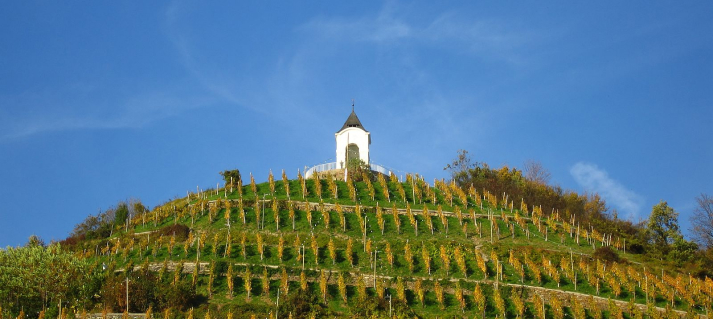
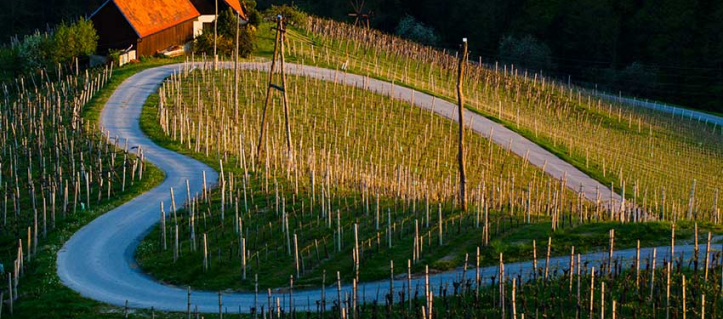
The winegrowing sub-district of Ljutomer-Ormož is considered one of the finest wine regions in Podravje and has a rich tradition. It encompasses an area from the Slovenian-Croatian border in the south to the Drava River in the north, and from the Pannonian Plain in the west, bordered by the winegrowing sub-districts of Srednje Slovenske gorice and Haloze. The central towns of the winegrowing sub-district are Ljutomer and Ormož, while the most important locations known for their exceptional vineyard sites include Jeruzalem, Slamnjak, Svetinje, Vinski vrh, Temnar, Železne dveri, and others.
Recommended grape varieties: Laški rizling (Welschriesling), Šipon (Furmint), Beli pinot (Pinot Blanc), Chardonnay, Sauvignon Blanc, Renski rizling (Rheinriesling), Sivi pinot (Pinot Gris), Muškat Ottonel (Muscat Ottonel), Rumeni muškat (Yellow Muscat), Traminec (Gewürztraminer), Dišeči traminec (Fragrant Traminer)
Allowed grape varieties: Zeleni silvanec (Sylvaner), Rizvanec, Ranina, Bela žlahtnina, Kerner, Modra frankinja (Blaufränkisch), Modri pinot (Pinot Noir), Rdeča žlahtnina, Zweigelt
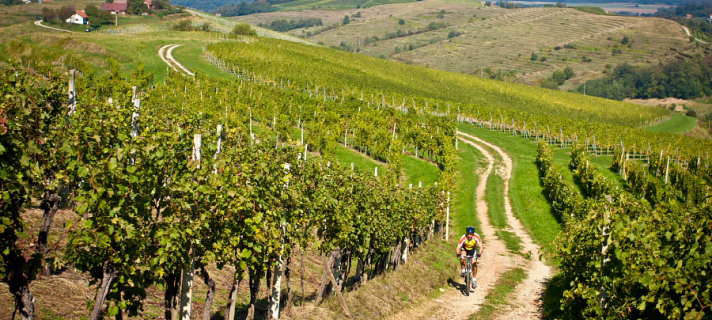
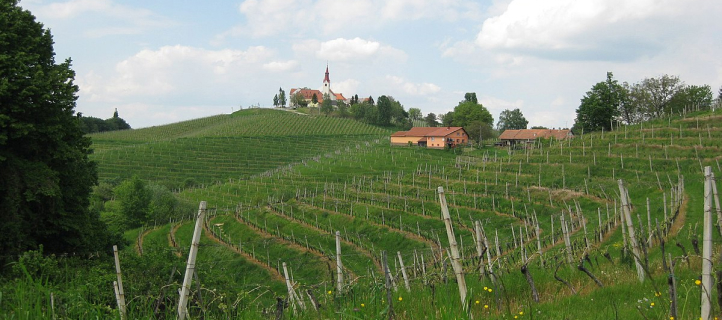
The winegrowing sub-district of Radgona-Kapela encompasses a narrow strip from the right bank of the Mura River to the Ščavnica River. The best vineyard locations are near the towns of Kapela, Police, Janžev Vrh, Kapelski Vrh, Murščak, and Hercegovščak. The winegrowing sub-district is most renowned for grape cultivation for sparkling wines, as well as for Traminer and the Janževec blend.
Recommended grape varieties: Laški rizling (Welschriesling), Renski rizling (Rheinriesling), Beli pinot (Pinot Blanc), Sivi pinot (Pinot Gris), Chardonnay, Sauvignon Blanc, Traminec (Gewürztraminer), Šipon (Furmint), Ranina
Allowed grape varieties: Rizvanec, Zeleni silvanec (Sylvaner), Muškat Ottonel, Rumeni muškat (Yellow Muscat), Modri pinot (Pinot Noir), Bela žlahtnina, Kerner, Modra frankinja (Blaufränkisch), Rdeča žlahtnina, Zweigelt

The Šmarje-Virštanj winegrowing sub-district encompasses the geographical area from Kozjansko to Bizeljsko. The best vineyard sites are located in the vicinity of Dramlje, Sladka Gora, Tinsko, and Virštanj.
Recommended grape varieties: Laški rizling (Welschriesling), Sauvignon, Beli pinot (Pinot Blanc), Chardonnay, Modra frankinja (Blaufränkisch), Modri pinot (Pinot Noir)
Allowed grape varieties: Zeleni silvanec (Green Sylvaner), Renski rizling (Riesling), Traminec (Gewürztraminer), Ranina, Rizvanec, Rumeni muškat (Yellow Muscat), Muškat Ottonel (Muskat Ottonel), Sivi pinot (Pinot Gris), Šipon (Furmint), Kraljevina, Kerner, Bela žlahtnina, Žametovka (Blauer Portugieser), Portugalka (Portuguese), Rdeča žlahtnina, Gamay, Zweigelt

Winegrowing sub-district Srednje Slovenske gorice is predominantly a hilly area suitable for viticulture in its southeastern part. In terms of climate, this area is transitional between the Maribor winegrowing sub-district and the lowlands along the Drava River. White wines are predominantly produced in Srednje Slovenske gorice, while red wines are mostly represented by Pinot Noir. The popularity of older varieties such as Žametna črnina and Portugalka has declined in recent times.
Recommended varieties: Laški rizling (Welschriesling), Beli pinot (Pinot Blanc), Chardonnay, Sauvignon Blanc, Šipon (Furmint), Dišeči traminec (Fragrant Traminer),
Allowed varieties: RuAllowed varieties: Rumeni muškat (Yellow Muscat), Rizvanec, Zeleni silvanec (Sylvaner), Sivi pinot (Pinot Gris), Traminec (Gewürztraminer), Renski rizling (Rheinriesling), Ranina, Ranfol, Kerner, Muškat Ottonel, Bela žlahtnina, Modra frankinja (Blaufränkisch), Portugalka, Modri pinot (Pinot Noir), Rdeča žlahtnina, Zweigelt, Gamay, Žametovkaay, Žametovka
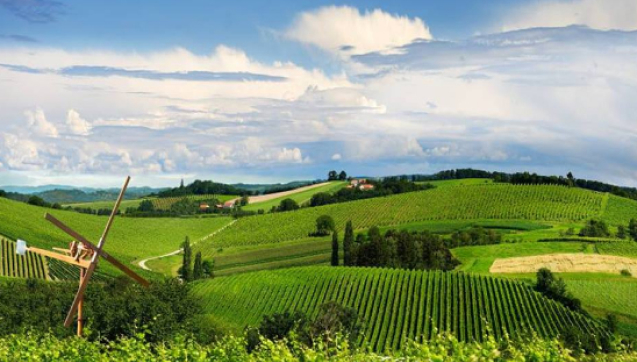
Haloze is a hilly region that stretches for 30 km along the right bank of the Drava River, south of Ptuj. The western side of the hills consists of forests, while the eastern side has been renowned for its vineyard sites since Roman times. The vineyards are arranged on steep slopes. Haloze borders the Posavje wine region to the south and the Maribor wine sub-region to the north. Today, winemakers in Haloze combine traditional knowledge of grape cultivation and the production of premium wines with favorable climatic, geological, and other conditions. Perhaps the most famous wine style from this region is Haložan.
Recommended grape varieties: Laški rizling (Welschriesling), Renski rizling (Rheinriesling), Šipon (Furmint), Sauvignon, Beli pinot (Pinot Blanc), Chardonnay, Rumeni muškat (Yellow Muscat), Muškat Ottonel (Muscat Ottonel), Traminec (Traminer), Dišeči traminec (Gewürztraminer), Sivi pinot (Pinot Gris), Modri pinot (Pinot Noir)
Allowed grape varieties: Zeleni silvanec (Sylvaner), Ranina, Rizvanec, Kraljevina (White King), Ranfol, Bela žlahtnina, Kerner, Rdeča žlahtnina, Modra frankinja (Blaufränkisch), Zweigelt
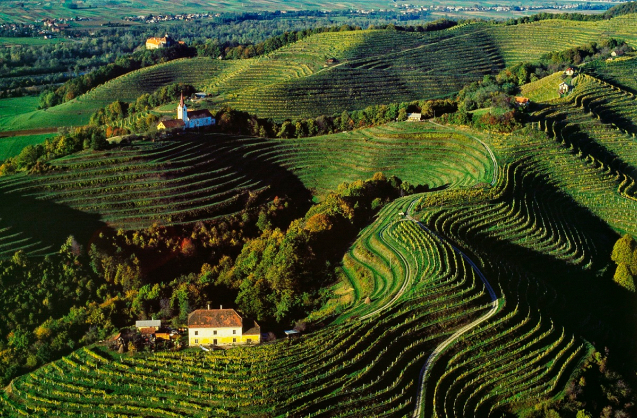
Among the 60 cultivated grape varieties, white varieties dominate. The most produced variety is Welschriesling (Laški Rizling), followed by Refosco, Chardonnay, Sauvignon Blanc, and Malvasia.
| Grape variety | % | ha |
|---|---|---|
| Welschriesling | 12% | 1800 ha |
| Refosco | 9% | 1320 ha |
| Chardonnay | 8% | 1180 ha |
| Sauvignon Blanc | 7% | 1150 ha |
| Malvasia | 6% | 950 ha |
| Žametovka | 5% | 780 ha |
| Merlot | 5% | 700 ha |
| Blaufrankisch | 4% | 650 ha |
| Yellow Muscat | 4% | 640 ha |
| Ribolla Gialla | 4% | 610 ha |
| Rheinriesling | 3% | 560 ha |
According to the data from the Statistical Office of the Republic of Slovenia (SURS), wine consumption in Slovenia amounts to approximately 35 liters per capita (2020/21), placing Slovenia among the top countries worldwide.
Similar to other EU member states, Slovenia has specific regulations regarding the labeling of its wines. Labeling of the quality categories of Slovenian wines entails additional requirements beyond European legislation (e.g., wine, sparkling wine, quality wine, quality sparkling wine, premium wine, premium sparkling wine).
An important additional requirement of Slovenian legislation, not foreseen by European legislation, is that wines must undergo evaluation before being placed on the market. Slovenian wines produced are mandatory to be evaluated by one of the five authorized organizations, including:
• Wines from the quality wines with protected geographical indication category;
• Regional wines with recognized geographical indication;
• Wines with a grape variety indication.
During the evaluation process, the authorized organization:
• Verifies the geographical origin data;
• Conducts a chemical analysis of selected components;
• Performs organoleptic assessment of the wine;
• Issues a decision on the wine evaluation (the decision number is then indicated on the label).
Slovenian still and sparkling wines are classified into different quality categories, which must be labeled accordingly, except for wines without a grape variety indication and wines without protected designation of origin (ZOP) or protected geographical indication (ZGO).
Web design: DigiTalk